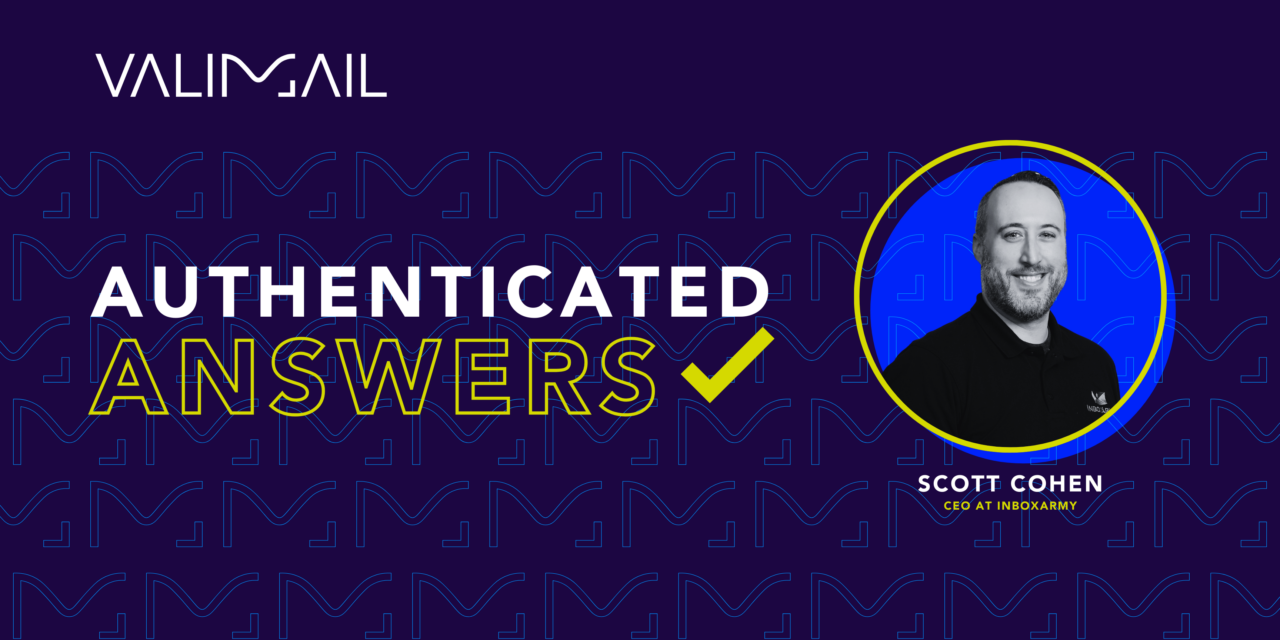Join us today with another interview in our blog series: Authenticated Answers! We sat down with Scott Cohen, CEO of InboxArmy.
At Valimail, we take our work seriously but try not to take ourselves too seriously. This value inspires us to get to the heart of what makes people unique and how it affects their careers to provide valuable advice, inspiration, and insights to people working with email daily.
In this lighthearted interview series, we connect with experts from the email, IT, security, ISP, and authentication spaces to learn more about them and their experiences.
About Scott Cohen

Though he began life as a copywriter, Scott has been a stalwart in the email marketing industry since his boss came to him and said, “Hey, you write the newsletters. Why don’t you do them?” Now serving as CEO of InboxArmy, the full-service email marketing agency, Scott brings his clients his unique combination of brand-side and agency-side email marketing experience.
Scott knows enough “to be dangerous” about email marketing, SMS, and all things CRM and retention marketing. He’s pressed the “Send” button a few thousand too many times and has the battle scars (and an award or two) to show for it.
Outside of the email world, Scott spends his limited spare time on the golf course, falling woefully behind on movies and TV shows due to children running around the house, and adding to a TBR pile of books with each passing week. His lone “claim to fame” is the brief time he spent on national TV when, as part of his college marching band (Go JMU Dukes!), he marched in the Macy’s Thanksgiving Day Parade right after 9/11.
How do you stay motivated when learning something challenging or frustrating?
I repeat to myself what I tell my children all the time: Everything in life that’s worth doing will be hard, especially at first.
Then I focus on micro-progressions. What are the small wins? What is my initial goal? In some cases, the initial win is getting to parity with my current processes. Then I say, “There’s got to be a better way.” And I work on that.
And if worse comes to worse, there’s coping with a nice Philly cheesesteak or a delicious dessert.
What was the last wall you crashed through?
“The skills that got you here are not the skills that get you there.”
One of the hardest transitions you have to make as a professional, if you indeed want to make this transition, is the transition from a Doer to a Manager. That quote above is what a previous boss told me when I was trying to get promoted. (For the record, this boss backed me 100%, but wanted me to realize what I was signing myself up for.)
Specifically for me, learning to delegate the day-to-day responsibilities to those who should be doing the work was a huge wall for me to crash through. The trust that’s involved with that isn’t just lip service. And the ability to not have to jump into those weeds every day, once I got comfortable, was actually freeing.

I wouldn’t say I’m an expert at it. My first instinct is to jump in. But now I have enough reps to know to curtail that instinct and ask questions and simply empower my people to do their jobs.
What’s your favorite way to show gratitude?
I say the words, “Thank you” or “Thanks” a lot. It’s a big deal to me. Even if it may seem like a throwaway to others, it just feels right. It’s important enough to me that I’m the parent that says “What do you say?” to my kids when the time is appropriate to say thanks.
Gratitude extends to credit given, too. I like to say, “When it’s good, it’s you – when it’s bad, it’s us.”
But otherwise, I’m not a “big gesture” kind of person. The closest I’ve gotten to that is that in years past, I’ve bought my team members DoorDash gift cards or the like during the holidays. A small token of appreciation for their hard work out of my own pocket.
What’s the funniest mistake you’ve made, and how’d you handle it?
It’s hard to pick one. I generally handle mistakes by:
- Owning up to them
- Fixing as soon as possible, whatever the issue might be
- Trying to laugh about it as soon as possible
I wouldn’t call this a mistake, but in the early days of the Covid lockdown, I don’t think companies had a good idea of how to handle employees who were home with their kids.
I was on a call with my team, videos on. My back was to the door to my home office. My then-5-year-old decided to sneak up on me while I was holding the meeting and talking very passionately about some topic. She then popped up and yelled something… causing me to literally jump out of my chair.
My team, thankfully, thought it was hilarious. (They saw her creep in behind me and said nothing, of course). But from then on, I adopted a “Hey, we’re all humans, we all have kids, dogs, cats, whatever – bring them on camera” mindset. After all, we’re remote. We can still be professional and personal at the same time.
What’s the smallest hill you are willing to die on?
Kindness towards others shouldn’t be hard. Neither should returning your shopping cart to the designated areas.
But the smallest hill I’m willing to die on is a sports-related hill. I’m a big (American) football fan. It drives me crazy when, especially in college football, where the hash marks are closer to the sidelines, a team runs a wide running play, like a toss sweep, to the “short side” of the field. I’ve almost never seen it actually work, and teams run to that side of the field all of the time.
As a data guy, it drives me crazy. As a football fan who sees this constant failure… yeah… I need to settle down.
What tips would you give to a new email marketer on deliverability?
You don’t have to turn into a deliverability expert to have the proper respect for this vital component of email marketing. After all, you can have the most beautiful, more conversion-focused email in the world, and it doesn’t amount to anything if it doesn’t get delivered.
So, get a general level of understanding of the following:
- The authentication protocols – SPF, DKIM, and DMARC
- Sender reputation and all of the factors that play into it
- Proper list-building practices (DON’T BUY LISTS!)
- Unsubscribe requirements
- Deliverability monitoring and the tools that can help you with it
- What responsibilities are yours as a program owner versus owned by your email service provider
And this: Respect the unsubscribe. If someone is going to leave your program, get them to unsubscribe. Do not rely on customers marking your emails as spam. In their mind, it acts the same way, but unsubscribes will not hurt your program in the same way spam complaints do.
How would you explain DMARC to your grandparents, friends, or relatives?
May not be the best analogy here, but I like to use bouncers as the visual. They’re trained to look for fake IDs for folks pretending to be the right age.
In the case of DMARC, the bouncers are looking at an email’s “ID” to try to determine if it’s actually you or someone pretending to be you. With DMARC in place, you are telling the bouncers what IDs to look for, and, depending on the level of setup you have, telling the bouncers whether these not-so-proper ID-carrying emails are allowed into the club.
Liked this interview?
Sr. Content Marketing Manager at Valimail
Alyssa Harmon



